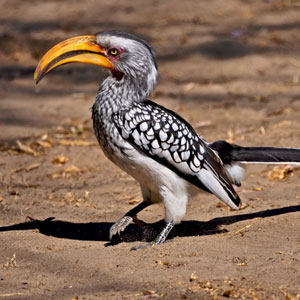Magazine | Études
Le champ de vision des calaos

Calao leucomèle (Tockus leucomelas).Photographie : Mathias / Wikimedia Commons
Introduction
54 espèces constituent la famille des Bucerotidés (calaos). Présents dans les forêts et savanes d’Afrique et d’Asie du sud, il s’agit d’oiseaux robustes, omnivores, d’une longueur allant de 38 cm à 160 cm et d’un poids de 85 g à 4 kg. Le Calao terrestre (Bucorvus leadbeateri) constitue le plus grand représentant de cette famille. Dans cette étude, Graham R. Martin, de la School of Biosciences (University of Birmingham, UK) et Hendri C. Coetze, du Ground Hornbill Research and Conservation Project (Afrique du Sud), présentent les résultats d’une étude remarquable sur les champs de vision des Calaos terrestre et leucomèle (Tockus leucomelas), afin de mieux comprendre leur technique de chasse, la « cueillette de précision ».
Abstract
Retinal visual fields were determined in Southern Ground Hornbills Bucorvus leadbeateri and Southern Yellow-billed Hornbills Tockus leucomelas (Coraciiformes, Bucerotidae) using an ophthalmoscopic reflex technique. In both species the binocular field is relatively long and narrow with a maximum width of 30° occurring 40° above the bill. The bill tip projects into the lower half of the binocular field. This frontal visual field topography exhibits a number of key features that are also found in other terrestrial birds. This supports the hypothesis that avian visual fields are of three principal types that are correlated with the degree to which vision is employed when taking food items, rather than with phylogeny.
However, unlike other species studied to date, in both hornbill species the bill intrudes into the binocular field. This intrusion of the bill restricts the width of the binocular field but allows the birds to view their own bill tips. It is suggested that this is associated with the precision-grasping feeding technique of hornbills. This involves forceps-like grasping and manipulation of items in the tips of the large decurved bill. The two hornbill species differ in the extent of the blind area perpendicularly above the head. Interspecific comparison shows that eye size and the width of the blind area above the head are significantly cor-related. The limit of the upper visual field in hornbills is viewed through the long lash-like feathers of the upper lids and these appear to be used as a sunshade mechanism. In Ground Hornbills eye movements are non-conjugate and have sufficient amplitude (30-40°) to abolish the frontal binocular field and to produce markedly asymmetric visual field configurations.
This study has been leaded by Graham R. Martin, School of Biosciences (University of Birmingham, UK) and Hendri C. Coetze, Ground Hornbill Research and Conservation Project (South Africa).
Poursuivez la lecture de cet article, en vous abonnant dès maintenant !
Découvrez les Archives d’Ornithomedia.com
Pour seulement 10,00 €TTC/an (ou 6,00 € les 6 mois)
Profitez de plusieurs centaines d’articles en accès illimité et sans aucun engagement.
Compléments
À lire aussi sur Ornithomedia.com
Comment voient les oiseaux et comment limiter les collisions ?
Ouvrages recommandés
- Anatomie Des Oiseaux de Frederic P. Miller, Agnes F. Vandome et John McBrewster
- Bird Anatomy II: The Surface Anatomy of Birds de Noble S. Proctor et Patrick Lynch
- The Inner Bird: Anatomy and Evolution de Gary W. Kaiser
- Le comportement animal : Psychobiologie, éthologie et évolution de David McFarland, René Zayan et Jacqueline d’Huart




Aucun commentaire sur ce sujet
Participer à la discussion !